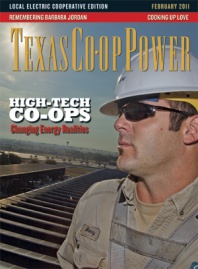Starry-Eyed
One of the “blessings” of the Great Ice Storm in East Texas about a decade ago, when the power went out, was being able to see the stars again like they looked to me as a country child back in the ’40s. We spent many a night looking at and talking about the Milky Way, planets and constellations back then. I never thought I could be deprived of the night sky, but my children and grandchildren don’t even have the memory of such grandeur. I am so glad to learn of the efforts being made in West Texas to preserve the heavenly view (“Starstruck,” December 2010). To visit there is on my bucket list—and it is a lot closer than the Australian Outback.
Betty Farrar, Bowie-Cass Electric Cooperative
I just read “Starstruck” in the December 2010 issue of Texas Co-op Power. Great article. I visit Big Bend and the surrounding area every November and never get used to the fabulous night skies. Gorgeous is a serious understatement. Everyone should see it at least once in their lifetime!
Ed O’Neill, Concho Valley Electric Cooperative
Your “Starstruck article” was really interesting. However, you missed a prime opportunity to inform electric co-op members of the steps that they can take to cut down light pollution all over the state. When we bought our place in north Collin County 16 years ago, we could see the Milky Way on most clear nights. Now, because of rural security lights, we rarely get to see it. We see the lights of McKinney to the west and Greenville to the east.
One neighbor about three-quarters of a mile away has installed a new light; now when we look out on the west pasture, we don’t see a dark field but rather a bright light through the trees. There are shields that can direct security light down to illuminate the grounds around the house without sending the light up into the sky. Co-ops should encourage their use.
Bill Marsh, Fannin County Electric Cooperative
Dad, I’m Really Lost Now
Reading Richard Husby’s truly Texan lexicon (“Scootch Over a Tad Bit,” December 2010) it took me back 20 years to when my son was only 4 years old. I was describing something to him that was “out yonder,” pointing as I explained. Looking somewhat confused, he waited until I had finished and asked “Dad, where is ‘Chonder?’ ”
Diction has never been one of my strong suits, but after all, I am a Texan. (Every day a pile of magazines lands on my desk. Yours is the only one I read from cover to cover and share with others.)
Steve Martindale, President, Six Flags Over Texas, Arlington
That About Covers It
In reference to the “Big Cover-up” article (December 2010), I believe there are better ways to have a warm bed with no power usage. I sleep on a featherbed with a down comforter. New ones have been “de-allergized.” Other options are silk-filled, wool-filled and cotton-filled—all natural fibers and quite comfortable. When the power is out, the bed is still warm.
This is an old-time alternative power solution that works phenomenally well, with only the initial cost, and lasts for decades.
Terry Fitzgerald, Karnes Electric Cooperative
My wife and I are retired senior citizens living in west Hamilton County where winter temperatures dip quite significantly. As most men are aware, it is not uncommon for wives to be more sensitive to the central air thermostat being set a few degrees lower; at 68 degrees, men might be comfortably warm, but their wives are cold.
In an effort to solve this problem and keep peace in the family, I bought my wife an electric blanket for wrapping around herself while we are sitting in our living room recliners watching TV, reading or whatever. She can easily adjust the blanket temperature, and I can remain comfortably warm with the central air set at 68 degrees. She loves this compromise while I enjoy a lower bill for heating with expensive propane gas.
We don’t choose to use an electric blanket or electric pad on our bed as mentioned in your article; just the traditional blanket layers. The thermostat is then adjusted around 64 degrees at night, producing even more savings on the utility bill.
I highly recommend your readers consider this proven option for keeping their wives warm and happy in the wintertime in Texas … or any place else for that matter.
John W. Roberts, Hamilton County Electric Cooperative
Ah, yes, electric blankets are grand. Even more so if the first one jumping into bed has only his/her side percolating, ready to snuggle the loved one arriving later!
Marie Kienlen, Guadalupe Valley Electric Cooperative
Ice Age
I enjoy reading Texas Co-op Power each month. I took a special interest in Clay Coppedge’s article “An Era Frozen in Time” (August 2010). I worked summers for Texas Public Utilities in 1945 and 1946. The company was bought by Southland Ice in 1947, and I worked there through 1948.
It really was a time of rationing of gas, tires, sugar, etc. This was a time when rural people came to town on Saturday to buy their goods. They would wait until they started home to come by the ice plant to get ice. Cars would be backed up a block or two.
I don’t think people had any idea how ice was made. It was frozen in cans and weighed 316 pounds per block.
P.S. All those iceman jokes are not just jokes.
Joe Worsham, Farmers Electric Cooperative


